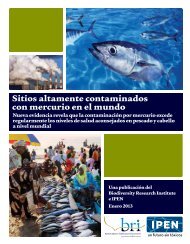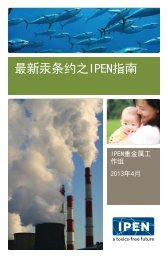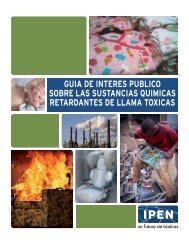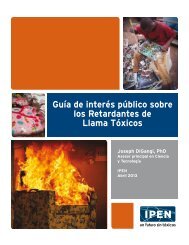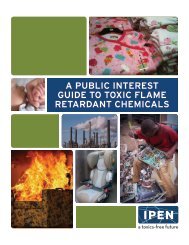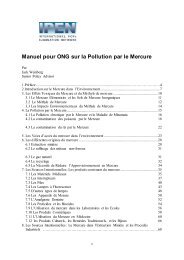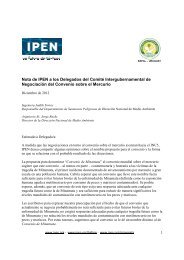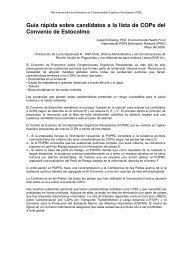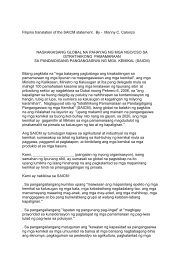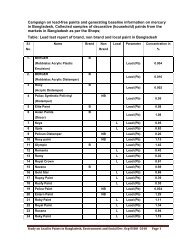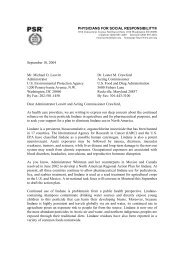The UNDP-GEF POPs Resource Kit - International POPs Elimination ...
The UNDP-GEF POPs Resource Kit - International POPs Elimination ...
The UNDP-GEF POPs Resource Kit - International POPs Elimination ...
Create successful ePaper yourself
Turn your PDF publications into a flip-book with our unique Google optimized e-Paper software.
ANNEX A<br />
SUMMARY OF THE PROVISIONS OF THE STOCKHOLM CONVENTION ON POPS<br />
35. <strong>The</strong> objective of the Stockholm Convention on Persistent Organic Pollutants (<strong>POPs</strong>)<br />
is to protect human health and the environment from <strong>POPs</strong>. <strong>The</strong> Convention is global in<br />
scope and multimedia in coverage. It focuses initially on twelve chemicals that can be<br />
grouped into the following three categories:<br />
(a)Pesticides–aldrin, chlordane, DDT, dieldrin, endrin, heptachlor,<br />
(b)hexachlorobenzene (also an industrial chemical and unintended byproduct), mirex and<br />
toxaphene;<br />
(c)Industrial chemicals – PCBs (also unintended by-products); and<br />
(d)Unintended by-products – dioxins and furans.<br />
36. Parties are obligated to take measures to reduce or eliminate releases of the <strong>POPs</strong><br />
covered by the Convention, namely:<br />
(e)Eliminate the production and use of <strong>POPs</strong> listed in Annex A to the Convention (aldrin,<br />
chlordane, dieldrin, endrin, heptachlor, hexachlorobenzene, mirex and toxaphene) with an<br />
exception for PCBs in use and certain limited exemptions;<br />
(f)Restrict to certain acceptable purposes the production and use of <strong>POPs</strong> listed in Annex B<br />
to the Convention -- DDT for disease vector control in accordance with WHO guidance --<br />
with certain other limited exemptions;<br />
(g)Restrict export of <strong>POPs</strong> listed in Annex A and B: (i) to Parties that have a specific<br />
exemption or allowable purpose, (ii) to non-Parties whose compliance with relevant<br />
provisions of the Convention is certified, or (iii) for the purpose of environmentally sound<br />
disposal;<br />
(h)Ensure that PCBs are managed in an environmentally sound manner and by the year 2025<br />
take action to remove from use PCBs found above certain thresholds;<br />
(i)Ensure, where countries have registered to do so, that use of DDT is restricted to vector<br />
control use according to WHO guidance and report on amounts of the chemical used;<br />
(j)Develop and implement an action plan to identify sources and reduce releases of <strong>POPs</strong><br />
byproducts listed in Annex C, including the development and maintenance of source<br />
inventories and release estimates, and promote measures including the use of best available<br />
techniques and best environmental practices; and<br />
(k)Develop strategies for identifying stockpiles of <strong>POPs</strong> listed in Annexes A and B, and<br />
products containing <strong>POPs</strong> listed in Annexes A, B and C, and take measures to ensure that<br />
<strong>UNDP</strong>-<strong>GEF</strong> <strong>POPs</strong> <strong>Resource</strong> <strong>Kit</strong>-----------------------------------------------------------------------------------------119



